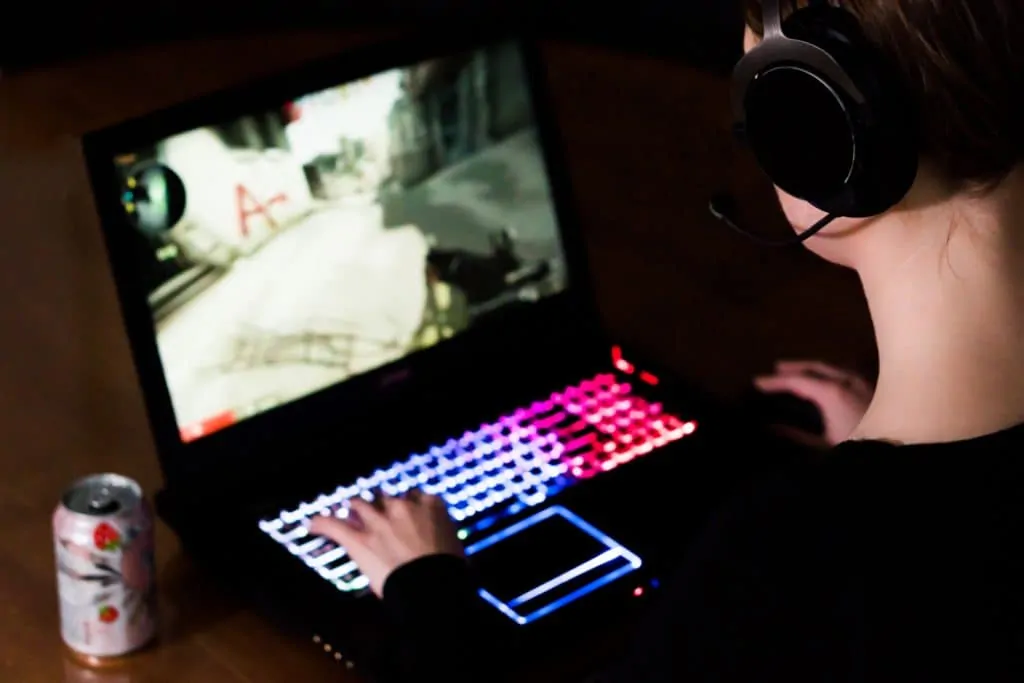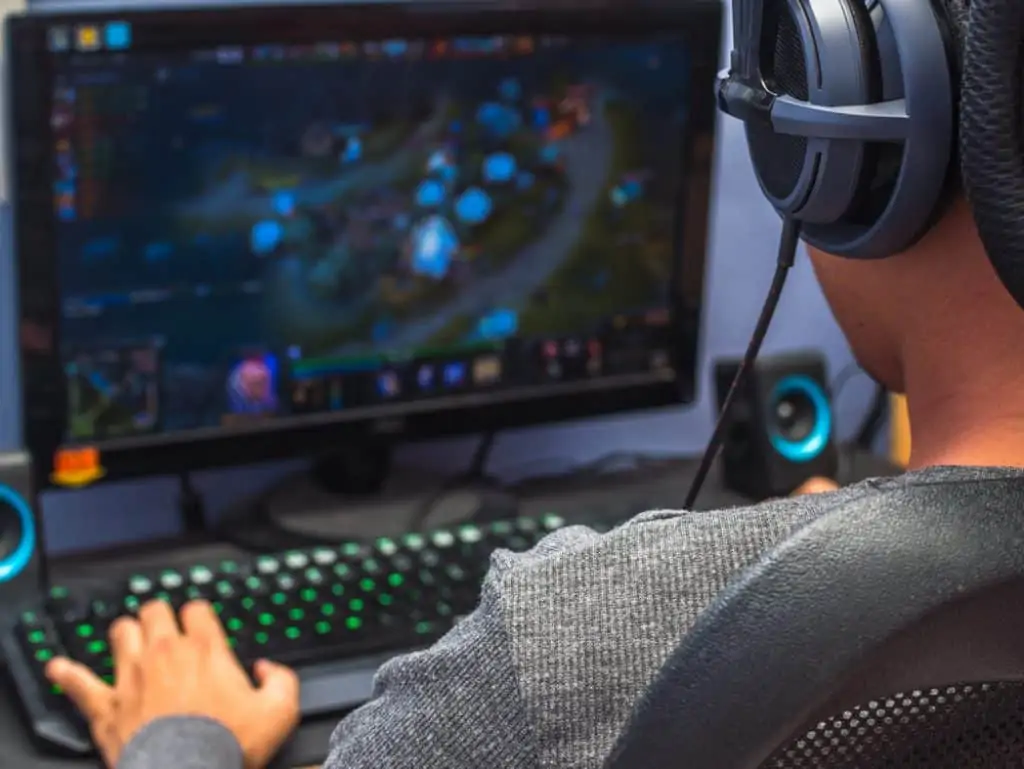Are you considering getting a high-end gaming laptop? If yes, you’re welcome to a comprehensive Dell G7 15 review.
This review contains an in-depth analysis of the specifications, design, and performance of the Dell G7 15. To determine the laptop’s performance, I’ll analyze its CPU, RAM, and battery.
In addition to that, I will also review the storage and GPU performances of the laptop. Furthermore, I will be comparing the Dell G7 15 with some of its competitors.
In addition to that, I will also provide ratings on each section of this review. After reading through, you will have enough information about the Dell G7 15.
My Initial Thoughts

This laptop is a redesigned model of its predecessor; the Dell G7 17 7790. The current 15-inch model of the G7 series was created to deliver high-performance in a smaller chassis.
Dell increased the standards of some specifications like multiple configuration options. They also maintained a variety of port options and a good display found on the predecessor.
However, Dell didn’t maintain the multiple storage options on this model. Wondering if it’s still a premium gaming laptop?
Read on to find out!
Dell G7 15 Design, Dimension & Weight Review

The Dell G7 15 has a premium look with its mineral black metal chassis. By the way, this is the only color variant Dell offers for this laptop.
In terms of dimension, Dell refers to this as a slim laptop with its 18 mm thickness. Well, for a gaming laptop it is slim, especially when compared with the Dell Alienware 15 (2019) which is 24 mm thick.
Regardless, the Dell G7 15 is neither a slim nor a bulky laptop.
To be exact, it has a dimension of 357.2 x 267.7 x 18.3 – 18.8 mm and weighs 2560g. The Dell G7 15 is heavier than the Gigabyte Aero 15 which weighs 1995g and has a dimension of 356 x 250 x 18 mm.
The ASUS ROG Zephyrus is another gaming laptop that is slimmer than the Dell G7 15. It has a dimension of 355.1 x 243.1 x 19.8 mm and also weighs 1900g.
Looks like the Dell G7 isn’t so slim in the real sense of the word. It is however lighter than the ASUS ROG Strix G15 which weighs 2998g.
Away from its dimensions, the brand logo is located in more than one area of the laptop. On the laptop’s lid, there’s the “Dell” iridescent logo which looks brighter when in contact with light.
Furthermore, there’s the “G7” logo at the back of the hinges and on the armrest of the keyboard layout. When you turn this laptop over, you’ll see the “G7” logo again occupying half of the laptop’s base.
The hinges on this laptop are quite firm. This is evident by the need to open the laptop’s lid with both hands.
Furthermore, these hinges are centrally positioned like the HP Omen 17 and Dell Alienware M15 R1. However, it’s still very balanced because of the extension of the chassis at the back of the lid.
Interestingly, once the lid opens, the laptop comes on. That’s right, you don’t need a power button on this laptop; even though it has one.
Dell G7 15 switches on automatically with light indicators below, thanks to the LED bar at the bottom of the trackpad. It’s pretty cool but if you want a break from it, you can turn it off using the Alienware software on the laptop.
When power comes on, the display before you is a 15.6-inch non-touch screen. Fortunately, Dell offers three display options on the G7 15.
There’s the Full HD (1920 x 1080) which actually has two options with minor differences. Also, there’s the 4K Ultra HD (3840 x 2160) resolution.
First is the Full HD display with 300 nits, 144 Hz, and 100% sRGB. The second is also a Full HD display which also has 300 nits, 300 Hz, and 100% sRGB.
Apparently, the main difference between the two Full HD display options is the refresh rate which is measured in Hertz (Hz). Refresh rate is the number of times an image changes per second.
This should matter to you if you’ll be using this laptop for gaming or video and photo editing.
Still on the display, Dell offers a third display option which is the 4K Ultra HD OLED screen. This display has 400 nits of brightness, 100% sRGB, and a 60 Hz refresh rate.
Additionally, all display options are anti-glare with a matte finish. The screen is also glossy so it can be really shiny and catches some reflection.
On the edges of the display are the bezels, the side and top bezels are quite narrow while the lower bezel is thick.
There’s no downside to this, it’s just appropriate with its 70.6% screen-to-body ratio. However, the Razer Blade 15 beats that with its 80% screen-to-body ratio.
Moving on to the deck of the laptop, there’s the keyboard and the touchpad. This touchpad is big which I really like – and it is also very responsive.
As for the keyboard, it is a 4-zone RGB backlit keyboard. Notably, you can change the colors of the backlit keyboard using the Alienware software on this laptop.
The keyboard is really smooth and provides a comfortable typing experience with a 1.5mm key travel. For clarity, key travel is how far a key goes down to the base of the keyboard on a single press.
Still on the keyboard, Dell included two keys with special features.
Forst, there is the “t-pad” designated key located at the top layer of the keyboard. On a single press, this t-pad turns off the touchpad when you don’t intend to use it.
Second, is the G-shift (game shift) key beside the ESC key. With just a press of this key, the GPU increases its performance speed.
Speaking of cooling, one major thing you’ll notice on this laptop’s chassis is the air vents. The Air vents are behind the hinges, the base of the laptop, and on its sides.
This must have been an intentional move by Dell to enhance the cooling system of this laptop.
Between the two vents behind the hinges of the laptop, you’ll see the HDMI port, RJ-45 Ethernet, Thunderbolt C, mini DP (display port), and a USB 3.2 port.
On the left side of the laptop, there’s the power in port, a USB 3.2 Gen 1 port, and a headphone jack. On the right of the laptop, you have the full SD card slot and a USB 3.2 port.
In brief, the Dell G7 15 has an impressive design, display, and overall build quality. I strongly believe that this gaming laptop deserves a nine out of ten in this design review section.
Dell G7 15 Processor (CPU) Performance Review

The Dell G7 7500 offers three 10th Gen Intel Core processor types to choose from. There’s the Intel Core i5-10300H, Intel Core i7-10750H, or Intel Core i9-10885H.
More specifically, the Intel Core i5-10300H is a quad-core processor with an 8 MB cache. It also has 2.50 GHz as its base frequency and 4.50 GHz as its boost frequency.
The second option is the Intel Core i7-10750H which is a Hexa-core processor with a 12 MB cache. Its base frequency is 2.60 GHz and its boost frequency is 5.0 GHz.
The most powerful option is the Intel Core i9-10885H which is an octa-core processor with a 16 MB cache. This processor has a base frequency of 2.40 GHz and a boost frequency of 5.30 GHz.
Notably, our review unit is the Intel Core i7-10750H which is a powerful processor that handles performance pretty well.
To test its processing power, I made use of the Cinebench R15. Cinebench R15 is a benchmark test tool that evaluates the hardware performance of the laptop.
At the end of this test, the Dell G7 15 7500 scored 6795 points. When compared with its competitors, we saw the ASUS ROG Zephyrus getting a score of 5458.
The Gigabyte Aero 15 is another comparing gaming laptop – it had a score of 6172 points. With the test scores above, we can say that the Dell G7 15 with the Intel Core i7 is a high performer especially when compared with its competitors
To sum it all up, the multiple processor configurations options and the CPU performance on this gaming laptop are very impressive. For these reasons, I will be rating it a nine in this category.
Dell G7 15 Memory (RAM) Performance Review

The Dell G7 15 7500 features an 8 GB DDR4 standard memory. This laptop also has two memory slots which means the memory can be upgraded.
Speaking of upgrades, this laptop supports a maximum memory of 32 GB. This means that the second slot of the memory can take an additional 24 GB of RAM
In terms of performance, this laptop handles multitasking very well. The memory was able to handle photo editing with Adobe Photoshop, web surfing with 16 tabs open, and downloading 5 high-resolution images all at once.
To further test the memory’s capacity, I used the PC Mark 10. This is a benchmark test that measures how the laptop performs in handling tasks; especially workplace tasks like video conferencing and web surfing.
At the end of this PC Mark test, Dell G7 15 scored 6086 points.
Comparatively, the ASUS Zephyrus S15 had a score of 5447. On the other hand, the Razer Blade 15 was closer to the Dell G7 15, with a score of 6739.
Apparently, the Razer Blade 15 has a strong memory performance compared to the Dell G7 15. Regardless, Dell G7 15 has an impressive performance and supports memory upgradability.
All things considered, I will be rating Dell G7 15 a nine for its excellent memory performance.
Dell G7 15 Storage Options & Performance Review

The Dell G7 15 7500 offers a single slot storage option of 512 GB M.2 2280 SSD. Despite being single slot storage, it can be upgraded to 1 TB.
For more options of expanding the storage, this laptop has a full SD card reader.
Personally, I didn’t find the storage options so impressive for a gaming laptop. I would have preferred two storage options on this laptop like the HP Omen 15 I reviewed some time ago.
Unfortunately, having only one storage slot with just a maximum of 1 TB limits the storage upgrade. Regardless, performance is as important as storage size, and for that reason, I tested the performance of the storage using the Crystaldiskmark.
Crystaldiskmark is a benchmark test that measures the performance of storage by accessing its read and write speed. If you’re wondering what “read” and “write” means, your computer performs a “read” when you open a file, for example.
On the contrary, a “write” operation occurs when you save a file on your computer. Needless to say that the faster a computer can read and write, the better overall experience you’ll have.
At the end of this test, Dell G7 scored 2924MB/s on its sequential read and 2821MB/s on sequential writes speed.
The ASUS ROG Zephyrus S15 scored lower on the same test with 1294MB/s as its sequential read speed. It also scored 2612MB/s as its sequential write speed.
Another gaming laptop that didn’t perform as well as the Dell G7 is the Razer Blade 15. It had a sequential read speed of 2260MB/s and its sequential write speed was 2135MB/s.
Despite its good performance, the storage option on this laptop is limited. For that reason, I will be rating it a seven out of ten.
Dell G7 15 Graphics Card Performance Review

Similar to the CPU, Dell provides six graphics configuration options to choose from.
Namely, there’s the Intel UHD Graphics, NVIDIA GeForce GTX 1650 Ti, NVIDIA GeForce GTX 1660 Ti. You can also get the laptop with NVIDIA GeForce RTX 2060, or NVIDIA GeForce RTX 2070 Max-Q configuration.
To start with, the Intel UHD Graphics is an integrated GPU with its base and boost frequency at 350 MHz and 1250 MHz respectively.
NVIDIA GeForce GTX 1650 Ti is another GPU option with 4 GDDR6 dedicated VRAM. It also has a base frequency of 1350 MHz and a boost frequency of 1485 MHz.
Next is the NVIDIA GeForce GTX 166 Ti with 6 GDDR6 dedicated VRAM. 1455 MHz is its base frequency and 1590 MHz is its boost frequency.
NVIDIA GeForce RTX 2060 is another graphics card that also has 6 GDDR6 dedicated VRAM. Its base frequency is 960 MHz and its boost frequency is 1200 MHz.
Lastly, there’s the NVIDIA GeForce RTX 2070 Max-Q with 8 GDDR6 dedicated VRAM. It has a base frequency of 1215 MHz and a boost frequency of 1440 MHz.
The NVIDIA GeForce RTX 2060 is better for good gaming and overall graphics performance.
Our review came with the NVIDIA GeForce RTX 2070 Max-Q. This GPU has been popular recently because of its ability to fit in thin laptops due to NVIDIA optimization for “peak efficiency.”
Despite that, we still advise that you stick with GPUs without Max-Q because they perform better than those with Max-Q.
To test the graphics performance of our review unit, I used the 3D Mark test tool.
The 3D Mark is a benchmark test designed to test a laptop’s 3D graphics rendering and processing power. This means that it checks how efficiently the laptop’s graphics run in a game and other graphic-intensive tasks.
For this 3D Mark test, the Dell G7 15 had a score of 6516 points. This is a slightly higher score than the Razer Blade 15 which score 6328 points.
Furthermore, to test its real-life gaming performance, I played some games. To start with, Anno 1800 played at 60 fps (frames per second) on 1080p medium settings.
On full 4K resolution settings, Grand Theft Auto V played also played at 60 fps. Yakuza 0 is another game that was playable at 60 fps on 4K Ultra resolution settings.
Meanwhile, while playing these games, the fan noise kept getting in the way. It gets even louder when you activate the “G-shift” key for improved performance.
At this point, you’ll probably want to use headphones to easily ignore the fan noise.
In a nutshell, all these are good gaming performances especially because they delivered good performance on high game settings. Well, that’s expected from such a premium gaming laptop anyway.
Despite the loud fan noise, I will be rating it a nine for its performance and multiple GPU configurations.
Dell G7 15 Battery life & Performance Review

When it comes to battery power, Dell offers two battery options to choose from when making a purchase. There’s the 3-cell, 56 WHr, or the 6-cell, 86 WHr Lithium-ion battery.
Notably, our review unit is the 6-cell, 86 WHr battery.
According to Dell, the G7 15 battery lasts for 6 hours. That is advertising anyway – so, to be sure, I carried out a real-life battery performance test.
To start with, I did a video playback test on YouTube with WiFi turned on. At the start of the test, the laptop was fully charged at 100%, and the laptop’s brightness was set at 50%.
At the end of this test, the laptop gave up at 8 hours 40 minutes. When compared to its competitor, the ASUS ROG Zephyrus S15 lasted 7 hours 23 minutes on the same test.
When I did some editing with Adobe premiere, Gimp, Photoshop, and After Effects, I only got 2 hours battery life. I also got the same 2 hours battery life with only gaming.
That’s expected since the laptop will also be making use of the GPU for running such tasks and intensive GPU tasks consumes battery. On a brighter note, the Dell G7 15 takes 2 hours to charge fully.
To sum up, gaming laptops don’t have the best battery life. However, the G7 15 battery performance is commendable and deserves a rating of nine.
Frequently Asked Questions

The Dell G7 15 7500 was launched in 2020
Yes. Dell offers an optional fingerprint sensor on this laptop
Yes. It tends to overheat during high-performance tasks like intensive and long gaming sessions
According to our battery test, this laptop lasts for 8 hours on average use.
The G-key is a new feature by Dell which allows you to boost the performance of the GPU with just the press of a button.
My Final Thoughts

The Dell G7 15 7500 is a solid performance laptop with a fair price point for its specifications. Because of how impressive it is in terms of design and performance, I expect this laptop to serve its purpose for a long time.
From its high gaming performance to multiple configuration options and premium design, the Dell G7 15 is a gaming laptop that ticks almost all the boxes.
I will advise getting this laptop if you’re a high-end gamer. It’s also suitable for those involved in high-graphics editing and needs a desktop replacement laptop for such tasks.
I hope you found this Dell G7 15 review helpful. If you found the review helpful, kindly spare 2 minutes to share your thoughts with [discourse_topic_url].
You could review this gaming laptop with our community members at [discourse_topic_url].
Finally, for more laptop reviews, visit our Laptop Reviews page. You may also find our Laptop Specs page very helpful.
Reference And Further Reading
- dell.com – Dell G7 15 7500 Setup and Specifications
- notebookcheck.net – Dell G7 15 7500, i7-10750H RTX 2060
- trustedreviews.com – Monitor Refresh Rates: Why higher isn’t always better
- gadgetsnow.com – Dell G7 7500 gaming laptop review: The gaming workstation
- indiatodaygaming.com – Dell G7 15 7500 gaming laptop Review: Impressive all rounder
- beebom.com – Dell G7 15 7500 Review: A Really Impressive Gaming Laptop from Dell
- nanoreview.net – Dell G7 15 7500
- m.economictimes.com – Dell G7 7500 review: The gaming workstation with attractive design
- laptopmag.com – Dell G7 15 (2018) Review
- laptopmain.com – Dell G7 15 7588 Review
- Dell G7 15 (7500)
- dell.com – Dell G-key feature
- tomshardware.com – What Is Nvidia Max-Q Graphics? A Basic Definition
- techarp.com – Dell G7 15 7500 Gaming Laptop : What You Need To Know
- [discourse_topic_url]



